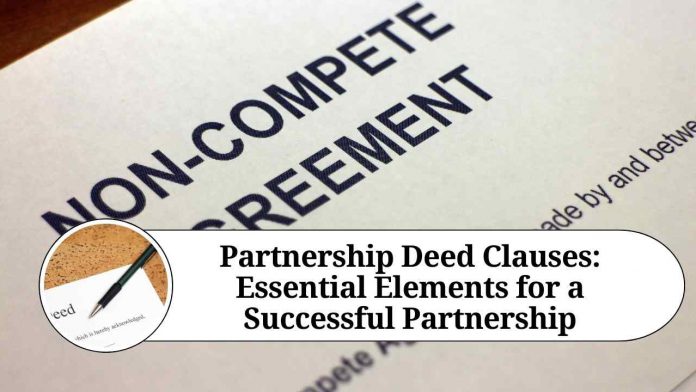Introduction of Partnership Deep Clases
- Name and address of the partnership: The first clause in a partnership deed should be the name and address of the partnership. This clause should clearly identify the name of the partnership and the physical address of its principal place of business.
- Purpose of the partnership: The partnership deed should clearly outline the purpose of the partnership. This clause should explain what business the partnership is engaged in, what products or services it provides, and any other relevant details.
- Capital contribution: This clause outlines the amount of money that each partner is contributing to the partnership. It should include the initial capital contribution, as well as any additional contributions that may be required in the future.
- Profit and loss sharing: This clause outlines how profits and losses will be distributed among the partners. This can be done in several ways, including sharing profits and losses equally or dividing them based on the percentage of capital contributed by each partner.
- Management and decision making: This clause outlines how the partnership will be managed and how decisions will be made. It should clearly identify the roles and responsibilities of each partner, as well as any specific decision-making procedures that must be followed.
- Term and termination: This clause outlines the length of time that the partnership will exist and how it can be terminated. It should include provisions for voluntary termination by the partners, as well as provisions for termination due to the death or incapacity of a partner.
- Dissolution and liquidation: This clause outlines the process for dissolving the partnership and liquidating its assets. It should include provisions for the distribution of any remaining assets after all liabilities have been paid.
- Non-compete and non-solicitation: This clause prohibits partners from engaging in any activities that compete with the partnership or soliciting the partnership’s clients or customers for a certain period after leaving the partnership.
- Partner’s responsibilities and obligations: This clause outlines the specific duties and responsibilities of each partner. It can include tasks related to operations, finance, marketing, sales, and any other areas that are relevant to the partnership’s business.
- Accounting and record-keeping: This clause outlines the procedures for maintaining accurate financial records and accounting practices. It should specify the type of accounting method to be used, how financial statements will be prepared, and who will be responsible for maintaining financial records.
- Partner’s authority: This clause outlines the authority of each partner to make decisions on behalf of the partnership. It should specify the types of decisions that require the unanimous consent of all partners, as well as the types of decisions that can be made by individual partners.
- Restrictive covenants: This clause can include a range of provisions that limit the actions of the partners. For example, it can prohibit partners from making unauthorized expenditures or engaging in activities that could harm the partnership’s reputation.
- Dispute resolution: This clause outlines the procedures for resolving disputes between partners. It can include provisions for mediation, arbitration, or other dispute resolution methods.
- Insurance: This clause outlines the insurance policies that the partnership should have in place to protect against risks and liabilities. It can include provisions for general liability insurance, property insurance, workers’ compensation insurance, and other types of coverage.
- Admission and withdrawal of partners: This clause outlines the procedures for admitting new partners into the partnership and for allowing existing partners to withdraw. It can include provisions for valuing the partnership’s assets and liabilities, as well as for distributing profits and losses among partners.
Other Related Blogs: Section 144B Income Tax Act
Frequently Asked Questions (FAQs)
Q: What is a partnership deed?
A: A partnership deed is a legal document that outlines the terms and conditions of a partnership agreement. It establishes the rights and responsibilities of the partners, the nature of the partnership, and the procedures for managing and operating the partnership.
Q: Why is a partnership deed important?
A: A partnership deed is important because it helps establish the terms of the partnership and the relationship between the partners. It can help avoid disputes and misunderstandings by providing a clear understanding of each partner’s responsibilities and obligations.
Q: What should be included in a partnership deed?
A: A partnership deed should include clauses related to the purpose of the partnership, capital contributions, profit and loss sharing, management and decision-making, termination, dissolution and liquidation, non-compete and non-solicitation, as well as other important clauses such as partner responsibilities, restrictive covenants, dispute resolution, insurance, and admission and withdrawal of partners.
Q: Can a partnership deed be amended?
A: Yes, a partnership deed can be amended if all partners agree to the changes. The amendment should be documented in writing and signed by all partners.
Q: Do I need a lawyer to draft a partnership deed?
A: It is recommended to seek legal advice when drafting a partnership deed, as it is a legally binding document that can have significant consequences. A lawyer can help ensure that the partnership deed is clear, comprehensive, and legally enforceable.
Q: Can a partnership operate without a partnership deed?
A: Yes, a partnership can operate without a partnership deed, but it is not recommended. Operating without a partnership deed can lead to disputes and misunderstandings between partners, and can make it difficult to manage the partnership effectively.
Q: Can a partnership deed be terminated?
A: Yes, a partnership deed can be terminated if all partners agree to terminate the partnership. The procedures for termination should be outlined in the partnership deed.
Q: What happens if a partner breaches the partnership deed?
A: If a partner breaches the partnership deed, the other partners may have legal recourse. The partnership deed should outline the procedures for resolving disputes between partners, which may include mediation, arbitration, or other forms of dispute resolution.




















